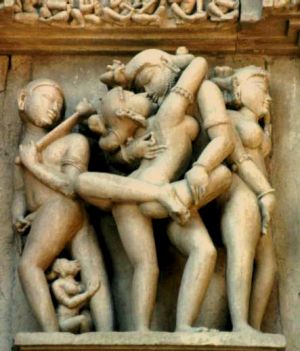Khajuraho Group of Monuments: Difference between revisions
meta>El C m (Reverted edits by 61.247.238.187 to last version by FlaBot) |
meta>Seemagoel (Adding text from www.exoticindiaart.com, written by Dr. P. C. Jain and Dr. Daljeet, released to Wikipedia with permission.) |
||
| Line 11: | Line 11: | ||
The Khajuraho group of monuments has been listed as a [[UNESCO]] [[World Heritage Site]]. | The Khajuraho group of monuments has been listed as a [[UNESCO]] [[World Heritage Site]]. | ||
== Architecture == | |||
Khajuraho temples, constructed with spiral superstructures, adhere to northern Indian shikhara temple style and often to a Panchayatana plan or layout. A few of these temples are dedicated to Jain pantheon while the rest to Brahmanical - to God's Trio, Brahma, Vishnu and Shiva, and various Devi forms. A Panchayatana temple had four subordinate shrines on four corners and the main shrine in the center of the podium, which comprises their base. | |||
With a graded rise secondary shikharas (spires) cluster to create appropriate base for the main shikhara over the sanctum. Kandariya Mahadeva, one of the most accomplished temples of the Western group, comprises eighty-four shikharas, the main being 116 feet from the ground level. These shikharas - subordinate and main, attribute to the Khajuraho temples their unique splendor and special character. With a graded rise of these shikharas from over the ardhamandapa, porch, to mandapa, assembly hall, mahamandapa, principal assembly hall, antarala, vestibule, and garbhagraha, sanctum sanctorum, Khajuraho temples attain the form and glory of gradually rising Himalayan peaks. | |||
== See also == | == See also == | ||
| Line 18: | Line 24: | ||
==External link== | ==External link== | ||
* [http://www.virtualtourist.com/m/23e1c/10b5e3/ Photos of Khajuraho temples] | * [http://www.virtualtourist.com/m/23e1c/10b5e3/ Photos of Khajuraho temples] | ||
* [http://www.exoticindiaart.com/article/khajuraho/ Love, The Living Spirit of Khajuraho] by Prof. P. C. Jain and Dr. Daljeet. | |||
* [http://www.dharssi.org.uk/travel/india/khajuraho.html Photos and travel tips for Khajuraho temples including maps showing how to get there] | * [http://www.dharssi.org.uk/travel/india/khajuraho.html Photos and travel tips for Khajuraho temples including maps showing how to get there] | ||
Revision as of 14:11, 17 September 2005
Khajuraho is a city in the Indian state of Madhya Pradesh, located about 385 miles (620 kilometres) southeast of Delhi, the capital city of India.

One of the most popular tourist destinations in India, Khajuraho has the largest group of medieval Hindu temples, famous for their erotic sculpture. The name Khajuraho is derived from the Hindi word khajur meaning date palm.
The city was once the religious capital of the Chandela Rajputs, a Hindu dynasty that ruled this part of India from the 10th to the 12th centuries. The Khajuraho temples were built over a span of a hundred years, from 950 to 1050. The whole area was enclosed by a wall with eight gates, each flanked by two golden palm trees. There were originally over 80 Hindu temples, of which only 22 now stand in a reasonable state of preservation, scattered over an area of about 8 mile² (21 km²).
The temples of Kajuraho is a perplexing example of religion laced with erotica. They are fine examples of Indian architectural styles that have gained popularity due to their salacious depiction of the traditional way of life during medieval time. They were rediscovered only during the 20th century and the jungles had taken its toll on some of the monuments.
The Khajuraho group of monuments has been listed as a UNESCO World Heritage Site.
Architecture
Khajuraho temples, constructed with spiral superstructures, adhere to northern Indian shikhara temple style and often to a Panchayatana plan or layout. A few of these temples are dedicated to Jain pantheon while the rest to Brahmanical - to God's Trio, Brahma, Vishnu and Shiva, and various Devi forms. A Panchayatana temple had four subordinate shrines on four corners and the main shrine in the center of the podium, which comprises their base.
With a graded rise secondary shikharas (spires) cluster to create appropriate base for the main shikhara over the sanctum. Kandariya Mahadeva, one of the most accomplished temples of the Western group, comprises eighty-four shikharas, the main being 116 feet from the ground level. These shikharas - subordinate and main, attribute to the Khajuraho temples their unique splendor and special character. With a graded rise of these shikharas from over the ardhamandapa, porch, to mandapa, assembly hall, mahamandapa, principal assembly hall, antarala, vestibule, and garbhagraha, sanctum sanctorum, Khajuraho temples attain the form and glory of gradually rising Himalayan peaks.
See also
External link
- Photos of Khajuraho temples
- Love, The Living Spirit of Khajuraho by Prof. P. C. Jain and Dr. Daljeet.
- Photos and travel tips for Khajuraho temples including maps showing how to get there
de:Khajuraho fr:Khajurâho kn:ಖಜುರಾಹೊ nl:Khajuraho sv:Khajuraho
